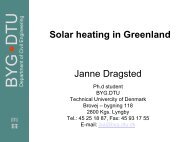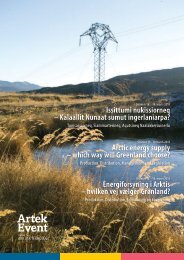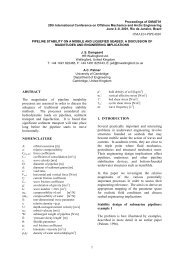Cantilever-like micromechanical sensors - Artek
Cantilever-like micromechanical sensors - Artek
Cantilever-like micromechanical sensors - Artek
Create successful ePaper yourself
Turn your PDF publications into a flip-book with our unique Google optimized e-Paper software.
IOP PUBLISHING REPORTS ON PROGRESS IN PHYSICS<br />
Rep. Prog. Phys. 74 (2011) 036101 (30pp) doi:10.1088/0034-4885/74/3/036101<br />
<strong>Cantilever</strong>-<strong>like</strong> <strong>micromechanical</strong> <strong>sensors</strong><br />
Anja Boisen, Søren Dohn, Stephan Sylvest Keller, Silvan Schmid and Maria Tenje<br />
DTU Nanotech–Department of Micro- and Nanotechnology, Technical University of Denmark, Bldg. 345 East,<br />
DK-2800 Kgs. Lyngby, Denmark<br />
E-mail: anja.boisen@nanotech.dtu.dk<br />
Received 25 May 2010, in final form 16 November 2010<br />
Published 28 February 2011<br />
Online at stacks.iop.org/RoPP/74/036101<br />
Abstract<br />
The field of cantilever-based sensing emerged in the mid-1990s and is today a well-known technology for<br />
label-free sensing which holds promise as a technique for cheap, portable, sensitive and highly parallel<br />
analysis systems. The research in sensor realization as well as sensor applications has increased<br />
significantly over the past 10 years. In this review we will present the basic modes of operation in<br />
cantilever-<strong>like</strong> <strong>micromechanical</strong> <strong>sensors</strong> and discuss optical and electrical means for signal transduction.<br />
The fundamental processes for realizing miniaturized cantilevers are described with focus on silicon- and<br />
polymer-based technologies. Examples of recent sensor applications are given covering such diverse fields<br />
as drug discovery, food diagnostics, material characterizations and explosives detection.<br />
(Some figures in this article are in colour only in the electronic version)<br />
This article was invited by H-G Rubahn.<br />
Contents<br />
1. Introduction 1<br />
2. Sensing principles 2<br />
2.1. Detection of mass changes 3<br />
2.2. Detection of surface stress changes 6<br />
2.3. Detection of effects related to bulk stress changes 9<br />
3. Sensor materials and fabrication 10<br />
3.1. Silicon-based devices 10<br />
3.2. Polymer-based devices 11<br />
3.3. <strong>Cantilever</strong>s with integrated functionality 13<br />
3.4. Comparison of materials and fabrication<br />
methods 14<br />
4. Sensor read-out principles 14<br />
4.1. Optical read-out 14<br />
4.2. Capacitive read-out 16<br />
4.3. Piezoelectric read-out 16<br />
1. Introduction<br />
The field of cantilever-based sensing is still relatively young<br />
and was initiated in the mid-1990s. The research area has<br />
since then been rapidly increasing in terms of both number of<br />
publications and research groups involved. Micrometre-sized<br />
cantilevers hold promises as label-free, sensitive, portable,<br />
cheap, highly parallel and fast <strong>sensors</strong> for field use and have<br />
thus attracted considerable interest from applications such<br />
as point of care (POC) diagnostics, homeland security and<br />
environmental monitoring. Moreover, the <strong>sensors</strong> offer the<br />
4.4. Piezoresistive read-out 17<br />
4.5. Hard-contact/tunnelling 18<br />
4.6. Autonomous devices 18<br />
4.7. Actuation 18<br />
5. Applications 19<br />
5.1. Surface functionalization 19<br />
5.2. Bacteria detection 19<br />
5.3. Point of care 20<br />
5.4. Drug discovery 20<br />
5.5. Explosives detection 21<br />
5.6. Material characterization 21<br />
5.7. Mass spectrometry 23<br />
6. Conclusion 23<br />
References 24<br />
possibility of measuring quantities and phenomena that are<br />
very difficult to achieve by other methods and they are therefore<br />
also very interesting fundamental research tools. Finally,<br />
the <strong>sensors</strong> can be operated in different modes which yield<br />
different information and which when combined can be used<br />
to obtain a unique set of coupled data. The <strong>sensors</strong> are versatile<br />
and can measure phenomena such as changes in surface stress,<br />
temperature and mass.<br />
The sensing technique has already been featured and<br />
compared with other label-free sensor technologies in several<br />
review papers [1–7]. The focus of this review will be on<br />
0034-4885/11/036101+30$88.00 1 © 2011 IOP Publishing Ltd Printed in the UK & the USA





